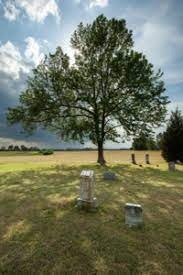Thomas Long
Blessed are those who mourn, for they will be comforted.
In the middle of a field near my home in rural Maryland there is an old family cemetery. Perhaps two dozen gravestones are huddled together there, the last one dated in the 1920s and the earliest a century before. Once an old farmhouse stood nearby but it is gone now. The farmer who leases this land carefully harrows around the graves, allowing his corn and soybean crops to embrace but not overrun these final resting places.
Generations ago this was a family farm, and whenever the shadow of death fell across this family–a man at the plow felled by a heart attack in the field, perhaps, or a woman claimed in a painful childbirth–the remaining members of the family would carry the body in their arms and place the deceased on the dining table. While the menfolk found a good spot in the cemetery among those who had gone before and dug a fresh grave, the women would tenderly wash and dress the corpse and place it on a bed or a cooling board. As word spread, neighbors would arrive with food and expressions of sorrow. In due course–a day, maybe two or three at most–the body would be placed in a newly made coffin and the lid fastened. The coffin would be lifted up and, as family and neighbors followed, carried across the field to the open grave. Prayers would be offered and words would be said–sometimes there was a member of the clergy present, sometimes not. Then the coffin would be lowered on ropes into the grave, the sod shoveled over it, and the bereaved would trudge home to continue the rhythms of their days.
Increasingly survivors decide to hold no public service at all, choosing privacy for whatever rituals of grief they may observe.

Cemetery Photo- Lutz Braum
Life is different now, of course. Family cemeteries are largely abandoned, curiosities in suburban subdivisions or shopping center parking lots, inconveniences for tractors and cultivators in fields. When there is a death, nobody goes into the pasture to dig a grave or places a body on the table to be washed and groomed. A commercial funeral home is summoned to take the body, which will most likely be cremated (slightly more than half of Americans are now cremated, and the rates are rising steadily). Usually there is still some kind of service, but now it is most often a “memorial service” without the corpse or, more euphemistically, a “celebration of life,” held after the disposition of the body. Increasingly survivors decide to hold no public service at all, choosing privacy for whatever rituals of grief they may observe. Cemeteries, even large public ones, are becoming relics of an earlier time. In his book Is the Cemetery Dead? David Charles Sloane chronicles the move of today’s younger generations away from institutional, culturally sanctioned, and stable rituals of death and toward more personal, informal, and fluid death practices, as represented by a rejection of cemeteries as memorials to the dead. “Will the millennial generation continue to embrace the cemetery,” he asks, “when they can celebrate an untimely death more immediately and informally? Or when they can publish a memorial web page accessible across the world rather than visit an often-inconvenient gravesite?”[1]
Human beings have always sensed that this movement to the grave or the fire is a sacred arc and the carrying of the dead body a sacred task.
Whatever social and psychological gains may be there in the newer, informal death practices, there are losses as well. First, current practices often neglect the sheer fact of the dead body, and there is wisdom to be found in the human necessity of taking the body to the place of final disposition. Whenever someone dies among the living, it is necessary to move the body, and fairly quickly, from the place of death to the grave, the fire, the sea or whatever will be the final resting place. In fact, historically this moving of the corpse from here to there is not something done after the funeral or before the memorial service; it is the funeral. The question is not really whether there will be a funeral. All dead bodies are taken to the place of disposition, and, thus, there is a funeral for each death. The question is, who if anyone will attend and what if anything will be said and sung and done as the body is transported?
Second, current practices often wash away the sanctity of the sheer act of performing a funeral. No human society has ever done the moving of a dead body from place of death to place of disposition in a perfunctory way, as if they were disposing of the trash. Human beings have always sensed that this movement to the grave or the fire is a sacred arc and the carrying of the dead body a sacred task. As they walk with the deceased to the place of disposition, stories are told, songs are sung, prayers are said. Carrying the deceased along the way is a moment both human and holy. As the fourth-century Christian document, The Apostolic Constitutions, counsels, “In the funerals of the departed, accompany them with singing. . . for precious in the sight of the Lord is the death of his saints.”[2]
Christian funerals, therefore, have always had a dual meaning. At one level, they bear honest witness to the continuing power of death, the final enemy, in human experience. As such, they are occasions for grief and sorrow. At another level, however, they testify to the power of Christ’s Resurrection and are occasions for confident joy. The Christian funeral itself, as a dramatic act, symbolizes the completion of baptism for the one who has died. At the beginning of the Christian life, this person was washed and anointed in baptism, and, now at the end, the body is washed and anointed at death. The deceased was fed at Christ’s table throughout life, and in the earliest Christian funeral practice, a eucharist was held at the grave. In the living of the Christian life, we bear one another’s burdens, and now at the end we bear the burden of the body of the one who has died. At one level, death has done its worst, and a life has come to an end. At another level, however, the Good Shepherd has carried a lamb home and life has come to its fullness.
This double intentionality of the funeral points to an important distinction that can be made between grief and mourning. Grief is the sense of loss, the season of weeping and sorrow, that death prompts. Except in the case of morbid grief, it lasts for a while, then lessens. Mourning, however, is more than a psychological state that comes and goes. Mourning is a theological posture that endures and is full of blessing, as expressed in Jesus’s second beatitude: “Blessed are those who mourn, for they will be comforted” (Matt. 5:4).
At one level, death has done its worst, and a life has come to an end. At another level, however, the Good Shepherd has carried a lamb home and life has come to its fullness.
As many have noted, the Beatitudes tend to fall into two clusters. Some describe ways of being that are in themselves blessed in the present moment, such as being meek, merciful, or pure in heart. Others, however, such as hungering and thirsting for righteousness and mourning, ground their blessing in the hope of a great reversal, that in the providence of God the conditions that provoke them will be overcome. As New Testament scholar John Meier has said,
Clearly, the beatitudes of Jesus are eschatological to the core. Human happiness is no longer defined by a wisdom limited to a human future. The mourners, the meek, the merciful are declared happy now. . . because they are certain that they will find consolation, inheritance, and mercy on the last day, when God sets things right. The future triumph of God, not the present misery of humanity, determines what true happiness is, however covert its operation in this present age.[3]
In the face of death, then, mourning is a protest against the power of death, a recognition that death is a violation of God’s will for life, and a hope for the reversal the Resurrection brings. Mourning is blessed, then, not because of death and loss but because of the great reversal, God’s promise to swallow up death in victory. The sound of grief is human weeping. The sound of mourning is the whole creation “groaning in labor pains” (Romans 8:22) and the faithful shouting defiantly, “Where, O death, is your victory?” (1 Cor. 15:55).
Sometime in the late nineteenth century, Christianity in the West began to lose its eschatological nerve. Funerals became less and less about carrying the dead to God and more about encouraging the bereaved to get past a difficult moment. Instead of being baptismal processions carrying the saints to glory, funerals focused on grief management, and, for the first time in human history the dead became unwelcome at their own obsequies. The sound of mourning “eagerly longing for the revealing of the children of God” (Rom. 8:19), gave way to the murmurs of therapy and finally to the giddiness of superficial “celebrations of life.”
When Christian funerals are performed well, we both grieve and mourn. We carry a loved one to the grave, and thus we grieve. But we do not “grieve as others who have no hope” (1 Thess. 4:13). We know that we are carrying that loved one beyond the grave to the embrace of God, and therefore we mourn the outrage of death and lean toward the comfort that will surely come. As Gregory of Nyssa said in a homily on this beatitude, “Comfort comes from partaking of the Comforter.”[4] This is why, in Luke’s version of the Beatitudes, the opposite of mourning is not mere psychological stability or lack of grief but laughter (Luke 6:21b, 25b). Laughter is provoked by the surprise of joy, the astonishment of resurrection, the sudden appearance of God’s reign. As theologian Jürgen Moltmann put it, “With Easter the laughter of the redeemed, the dance of the liberated and the creative play of fantasy begins.”[5]
 Thomas G. Long is the Bandy Professor of Preaching Emeritus at Candler School of Theology at Emory University. Dr. Long has served as the president of the Academy of Homiletics and as senior homiletics editor of the New Interpreter’s Bible. He is an editor-at-large at The Christian Century, and his most recent books are What Shall We Say? Evil, Suffering, and the Crisis of Faith; The Good Funeral: Death, Grief, and the Community of Care (with Thomas Lynch); and 1 and 2 Timothy and Titus.
Thomas G. Long is the Bandy Professor of Preaching Emeritus at Candler School of Theology at Emory University. Dr. Long has served as the president of the Academy of Homiletics and as senior homiletics editor of the New Interpreter’s Bible. He is an editor-at-large at The Christian Century, and his most recent books are What Shall We Say? Evil, Suffering, and the Crisis of Faith; The Good Funeral: Death, Grief, and the Community of Care (with Thomas Lynch); and 1 and 2 Timothy and Titus.
[1] David Charles Sloane, Is the Cemetery Dead? (Chicago: The University of Chicago Press, 2018), 6.
[2] Apostolic Constitutions 6:30.
[3] John P. Meier, “Matthew 5:3–12,” Interpretation, 44/3 (July 1990), 283.
[4] Gregory of Nyssa, “Homily III (on Mt. 5:4)” in Hubertus Drobner and Albert Viciano, eds., Gregory of Nyssa: Homilies on the Beatitudes (Leiden: Brill, 2000), 46.
[5] Jürgen Moltmann, The Church in the Power of the Spirit (New York: Harper and Row, 1977), 110.
